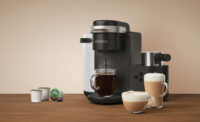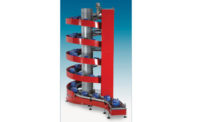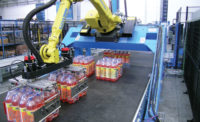Wrap It Up
By JOANNA COSGROVE
Speed and versatility are paramount to getting the
job done efficiently
Case packaging and
wrapping equipment are among the final pit stops for beverages before they
depart the manufacturing facility. And just as processing speed,
flexibility and efficiency are top goals for each piece of equipment in a
beverage processing line, so too are they the key components of case
packaging and wrapping machines.
“Speed has certainly been a huge driver in
today’s marketplace,” says Kris Kolstad, vice president of
marketing and sales at Standard-Knapp, Portland, Conn. “Every bottler
is trying to get ‘more out the door’ with the same number of
people and same number of lines, rather than adding new plants.”
But Kolstad emphasizes that speed is only one
component of success, especially when it comes to “measurable
efficiency.”
“Speed is important but it’s directly
coupled with reliability and efficiency,” he says.
“There’s been a huge focus in recent years on setting goals and
measuring line efficiencies. An industry rule of thumb is that line
components must perform at 98 percent or better in order for bottlers to
get total line efficiencies above 85 percent. If you’re only running
at 60 percent, you’re not getting the cases out the door.”
Flexibility in manufacturing also continues to be a
big focus, especially for beverage companies that regularly produce
multiple SKUs. “For example,” Kolstad explains,
“Coca-Cola might have had had just three different container sizes 20
years ago. Today, Coke is into bottled water, sports drinks and other
beverages in addition to their soft drinks so they require equipment that
can run more than one type.
“Case packaging equipment needs to be adjustable
to flexibly accommodate that variety as well quick, nimble changeovers
— quick and nimble meaning that once it is changed over, the machine
runs without further adjustments,” he adds.
But one of the biggest buzzwords when it comes to case
packers and wrappers is robustness. “Equipment robustness is
important because as material variations occur, the machine must still run
efficiently,” he says. “It also needs to be robust in the sense
that it must accommodate operators of various skills and literacy levels,
especially for somebody whose primary language isn’t English. You
need a user-friendly interface — one of the biggest challenges
continues to be the ‘people part.’ Skill sets and literacy
rates vary from plant to plant, region to region.”
In addition to the aforementioned components of
in-demand case packers and wrappers, Jeff Williams, director of business
and planning, R.A. Jones & Co. Inc., Covington, Ky., adds that other
top attributes include equipment that comes with reliability and efficiency
guarantees, ergonomic features, a small footprint, minimal changeover time
and repeatability.
New packing equipment
A variety of new beverage packing equipment has hit
the market recently. Among the new options is the Beverage Meridian
multi-packer machine from R.A. Jones, which created the system to provide
high output and application adaptability for beverage can packaging. The
unit’s standard features include metric stainless steel design, left-
or right-hand configurations and can sizes from 8 to 16 ounces.
Beverage Meridian machines can be configured for
single-tier six- to 24-can packs. Dual pitch provides the highest possible
pack speeds (up to 210 packs per minute), at the lowest possible linear
speeds, translating into half the wear on components. The reduced linear
speeds also permit pack and flap handling at much lower velocities and
accelerations for more precise control.
The electrical and mechanical components were
engineered for longevity with minimal cost for maintenance and repairs. To
further enhance operational efficiency, quick changeovers can be performed,
typically in 10 to 30 minutes.
Standard Beverage Meridian machines feature direct
coupled servos and belt drives providing automatic pitch changes on the
transport during size changeovers and smooth pick-off and opening on the
three-head rotary carton feed.
Schneider Packaging Equipment Co., Brewerton, N.Y.,
manufactures versatile packing solutions for gable-top cartons. According
to Paul Burdick, the company’s director
of sales and marketing, the gable-top packer is designed to accept the
output of any of the current fillers on the market. “The packer also
will deliver output in three-, four-, six- or eight-packs, all of which are
required at various times by our customers in the juice and dairy
industries,” he says.
Currently installed in juice and dairy facilities, the
gable-top case packers can be designed as a horizontal, or a top- or
bottom-load vertical case packer, and packs half-gallon gable-top cartons
into corrugated containers at speeds up to 33 cases per minute (cpm),
depending on pack pattern.
To meet the demands of improved throughput and 24/7
reliability, the high-speed horizontal case packer is designed for
repeatable, rapid changeovers from three-pack convenience cases to four-,
six- and eight-pack case for half-gallon style cartons. Schneider also
offers other machine designs to accommodate half-pint, pint, quart and
gallon-sized cartons. Features include, Allen Bradley Logix controls, a
multiple case size magazine, touchscreen operation and diagnostics.
The Packmore from Standard-Knapp is a high-speed
continuous-motion case packager offering precise servo product grouping,
soft placement of bottles into the case and
automated changeover. Low maintenance and high reliability are achieved
through the positive, continuous operation from the infeed through
placement of bottles into the case.
The Pakmore includes features such as a pressure-less
zero-gap infeed, the flexibility of an inline or peninsula layout, and
positive packing action that places the bottles in the bottom of the case.
Other features include smart and quick fault recovery systems and robust
construction designed for facilities that operate on 24/7 production
shifts.
New wrappers roundup
Launched last August, the Wraptor multi-wrap machine
from R.A. Jones is the latest addition to the company’s family of
paperboard multipack/wrap solutions. Wraptor machines can be configured for
single-tier wrap of one to six packs and double-tier wrap of two to 12
packs with many product/container types — round, oval, square,
rectangular and irregular.
The unit’s standard features include metric
design, left- or right-hand configurations and speeds up to 250 packs per
minute. A standard static locking closure eliminates the need for glue,
although a glue or combination glue/lock is optional. The Wraptor can
handle cans, bottles (glass or plastic), cups, bowls and tubs. To further
enhance cost economies and application flexibility, the Wraptor is
engineered to efficiently run a broad spectrum of materials, including
economical commodity board.
The unit also offers operational efficiencies for
customers. Changeovers can be performed in as little as five minutes, in
many cases with no tools required. The space-efficient design minimizes
floor space, while aiding installation and application versatility.
Lubrication-free chains complement stainless construction in the
“clean machine” design. Guarding and controls are ergonomically
designed for operator convenience. Standard Wraptor machines feature
Allen-Bradley Compact controls and Panelview touchscreen HMI. A standard
electrical platform provides cost-effective application in U.S., European
and other world markets.
Polypack Inc., Tampa Bay, Fla., offers two wrapping
solutions for the beverage segment: the ILB24L-P and the Cha Cha Cha Shrink
Bundler. The ILB24L-P is described as a versatile shrink-wrap solution for
multipacks that bundles/wraps any configuration of bottles, boxes and odd
shaped articles. The unit’s no transfer wrapping also allows unstable
product multipacks to be produced. In a single lane configuration, the unit
boasts production speeds up to 50 wraps per minute. In a double lane
configuration, the unit can complete up to 100 wraps per minute.
Polypack’s Cha Cha Cha print registered shrink
bundler is touted as one of the most affordable shrink bundlers capable of
running print registered film. The compact unit uses either single or
double rolls of film (clear or print registered) with film repetitions up
to 40 inches in length and provides the versatility to run a wide range of
products. The Cha Cha Cha’s small footprint is complemented by
electro-mechanical motions and is controlled by three-phase motors and
inverters or by servos. No air or vacuum is required for operation.
With a compact stainless steel design, the versatile
Cha Cha Cha processes 60 bundles per minutes with no seal bar and a user-friendly color touchscreen. BI
Canned heat
Self-heating can puts the “ahh” in latte
Imagine enjoying a hot
latte or cocoa without having to trek to the local coffee shop.
That’s just what OnTech Delaware Inc.,
San Diego, Calif., had in mind when it developed a perfectly portable self-heating can designed to accommodate the fast-paced
lifestyles of commuters, mobile professionals and sports and recreation
enthusiasts who might not have access to conventional heating sources.
After eleven years of development, OnTech’s
self-heating can debuted last March. In December, the company introduced a
new product line of self-heating beverages under the “Hillside”
label, which includes four lattes (Hazelnut, French Vanilla, Mocha and
Double Shot), two hot cocoas (Chocolate and Chocolate Marshmallow), two tea
lattes (Chai Tea Latte and Green Tea Latte) and three soup items. Hillside
lattes began shipping late last year to test markets in the Northeast, and
the soups, hot cocoas and teas will begin shipping this month. According to
Rick Bauman, senior vice president, sales and marketing at OnTech, more
than 20 self heating beverage SKUs will available by April.
“We have had great response from retailers and
consumers in the Northeast,” Bauman says. “Our initial Hillside
latte sales are very strong and we are finding that awareness is crucial to
success due to the unique attributes of the self-heating technology. Our
launch campaign sums it up in ‘It Does What?’ as this is a
first-of-its-kind consumer product. Thus, educating the consumer is the key
to success.”
Can construction
The OnTech self-heating container is built from
two main parts: the container and the actuating “puck.” The
container comprises an inner cone that holds calcium oxide (quicklime), and
the outer container body, which holds the beverage product. The puck holds
water and is sealed by a foil membrane.
The container is heated when the consumer pushes a
button on the bottom of the container, breaking an inner seal that allows
water to pass into the heating cone where it mixes with calcium oxide. Once
these materials combine, an exothermic reaction occurs and the heating
process begins. Approximately six to eight minutes after activating the
container, a thermal ink spot indicates when the product is ready for
consumption.
The container heats beverages to approximately
145º F for a minimum of 20 minutes and keeps the beverage warm for up
to an hour.
The body of the container is a special six-layer
construction made from a combination of several FDA-approved, foodgrade
plastics chosen for their optimal heat transfer and insulation properties. With the exception of its metal lid and foil
seal, the entire container is made from blowmolded and injection-molded
plastic.
At its peak temperature, the self-heating container is
designed to be more comfortable to the touch than an ordinary metal can.
And according to the company, the beverage remains hot longer than if
heated by another means (stove, microwave, etc.) because the exothermic
reaction continues to heat the beverage.
The OnTech container is primarily composed of
polypropylene (PP) and was designed to meet guidelines required for
recyclability. The container has been awarded the Grune Punkt (The Green
Point) which acknowledges that the container has been approved for
utilization in the strict European recycling and waste system. BI


